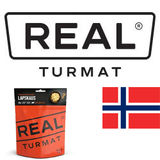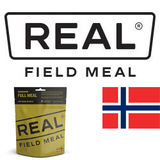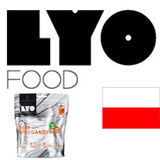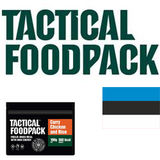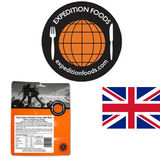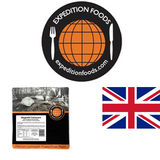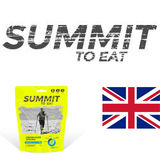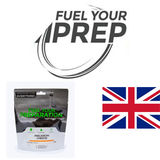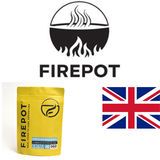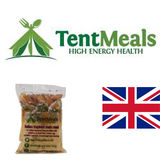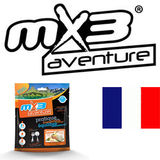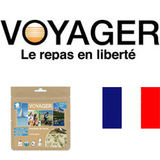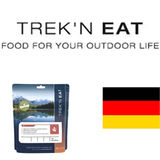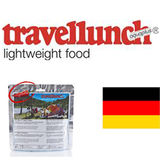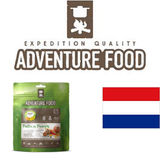Comparison between freeze-fried/dehydrated meals
In what situations is rehydrated food used?
Rehydrated food is convenient if you want to eat well while hiking, trekking, climbing for a self-sufficient race like the Marathon des Sables, or even sailing to lighten the load. Indeed, these ultra-light meals are essential for these activities that require self-sufficiency over several days.
Rehydrated foods, particularly freeze-dried ones, can also be easily stored at home in case of emergencies (storms, power outages, supermarket supply stops...) due to their space-saving nature and long shelf life.
In Europe, many manufacturers sell rehydrated meals. On lyophilise.fr, you can choose your meals from several hundred recipes. The choice is extensive - around 550 recipes - including breakfasts, main courses, desserts, staple foods, fruits, cheeses, vegetables...

|
How to choose your rehydrated meals?
Many questions arise before going on an expedition! Between the number of calories to take, the constraints you will face, the equipment you have, and the little luxuries you wouldn't give up for anything, the backpack weight increases quickly.
Depending on the adventures, freeze-dried/dehydrated foods will play a secondary role when fresh products are available or can be combined with cooked meals. They will be there as backup meals, and you need to be mindful of the number of calories. Sailors, for example, appreciate an extra hot meal that is quick to prepare during their night shifts. Freeze-dried/dehydrated food is perfect for this situation!
If the option of "all" freeze-dried/dehydrated from breakfast to dessert is chosen (desert marathons, around-the-world sailing races...), variety, taste, and recipe quality should be the "leitmotif" for a successful selection while always ensuring to bring the right number of calories.
The diversity of freeze-dried/dehydrated recipes allows for selections that cater to people with food intolerances while delighting everyone's taste buds.
Finally, the budget is a criterion to consider because, as you will discover, there are many rehydrated recipes... but not all are freeze-dried. This affects the cost and the nutritional quality of the meal.
We have therefore decided to give you a little comparison of all rehydrated meals based on origins, packaging, preparation type, shelf life, calories, portions, choices, and budget.
What are the different types of rehydrated meals?
- 100% freeze-dried
- Mix of dehydrated and freeze-dried ingredients
- 100% dehydrated
Each of these meal preparation methods has its own advantages. We explain below the differences between these manufacturing methods.
What is a 100% freeze-dried meal?
All the producers listed below cook and freeze-dry their meals. The ingredients are therefore simmered together.
How do they freeze-dry them?
1. They prepare their meals and freeze them to -40°C in a freeze-dryer.
2. They remove the air from the freeze-dryer.
3. They bring the freeze-dryer from -40°C to 0°C. The water in the food changes from solid to gas without passing through the liquid state, which is called sublimation.

The advantages of freeze-dried food?
These freeze-dried meals have several advantages:
- More caloric per 100 g compared to dehydrated meals, averaging around 500 kcal per 100 g depending on the dish.
- Possibility of rehydrating with cold water if making a fire is not possible, unlike dehydrated foods. Note: rehydration with cold water takes twice as long as rehydration with boiling water.
- Long shelf life: packets can be stored for 3 to 8 years depending on the brand, and cans up to 25 years after the manufacturing date.
- No additives or preservatives (except for a few recipes with eggs, for example).
The only downside: the prices are higher than dehydrated meals or meals mixing freeze-dried and dehydrated ingredients. Indeed, the larger the food item, the more time and energy it takes to freeze-dry, as with the LyoFood brand. This is why, in most cases, pieces of meat, fish, and poultry are small to reduce the process cost. But freeze-drying is of higher quality than dehydration, preserving about 95% of the nutritional value of freeze-dried products. Other methods, like dehydration, retain only 60% of the nutritional value because the heat destroys some vitamins and minerals.
Did you know? Only the sauce is in powder form. Ingredients such as starches, meats, and vegetables are distinct in the packet.
Here are the brands that cook and 100% freeze-dry their meals, highlighting their specificities:
Definition of a 100% dehydrated meal
Dehydration, drying by heat, is an ancient method of preserving food.
It aims to remove enough water from the product (up to 94%) to allow for better preservation and also to reduce the weight of the food. This process is less energy-intensive than freeze-drying, but the reactions that occur during dehydration affect the taste and nutritional quality. Depending on the food, dehydration is estimated to cause a loss of 10 to 50% of nutrients.
These dehydrated meals have a shorter shelf life than freeze-dried meals, about 2 years after the manufacturing date. But this process is much less expensive as it simply requires heating the product.
You can dehydrate ingredients yourself, such as fruits, in a dehydrator.
Did you know? These meals must be rehydrated with hot water, unlike freeze-dried meals that can be rehydrated with cold water.
Focus on brands:
- Firepot cooks all their meals themselves, just like at home, then dehydrates them without adding anything else.
- Tentmeals offers breakfasts and main courses, suitable for a vegan diet, by mixing dehydrated ingredients.
Mix of freeze-dried and dehydrated ingredients
All the brands listed below mix freeze-dried (dried by cold) and dehydrated (dried by heat) ingredients.
Why this method?
Cooking a recipe in its entirety does not allow for large-scale production. To remedy this, it is possible to dehydrate or freeze-dry just one ingredient in large quantities to reduce manufacturing costs. To obtain a recipe, it will suffice to add the freeze-dried or dehydrated ingredients and combine them in a packet.
This does not necessarily mean that the resulting recipe will be of "poor" quality. Less fragile foods such as starches can be dehydrated and combined with more noble ingredients that have been freeze-dried, like meat, for example.
The disadvantages of these meals are that they cannot be rehydrated with cold water because they contain dehydrated foods. Additionally, these ingredients have not been cooked and simmered together. This can sometimes lack flavor compared to a 100% freeze-dried meal.
Outdoor meals that meet everyone's needs
Nowadays, brands develop various recipes to meet everyone's needs or to respect food intolerances. These recipes will satisfy all food lovers even if they have no particular dietary constraints:
- Organic selection
- Vegan selection
- Gluten-free selection
- Lactose-free selection
- Double-portion selection
Feedback: Do you have a favorite brand?
We are in contact with all our manufacturers and suppliers with whom we have trusted relationships. It is very difficult for us to choose a particular brand. It depends on each person's tastes, budgets, and cultures. That's why we have so many choices!
If you have feedback, an anecdote, or a review to share with us, please send us your experience by email!



